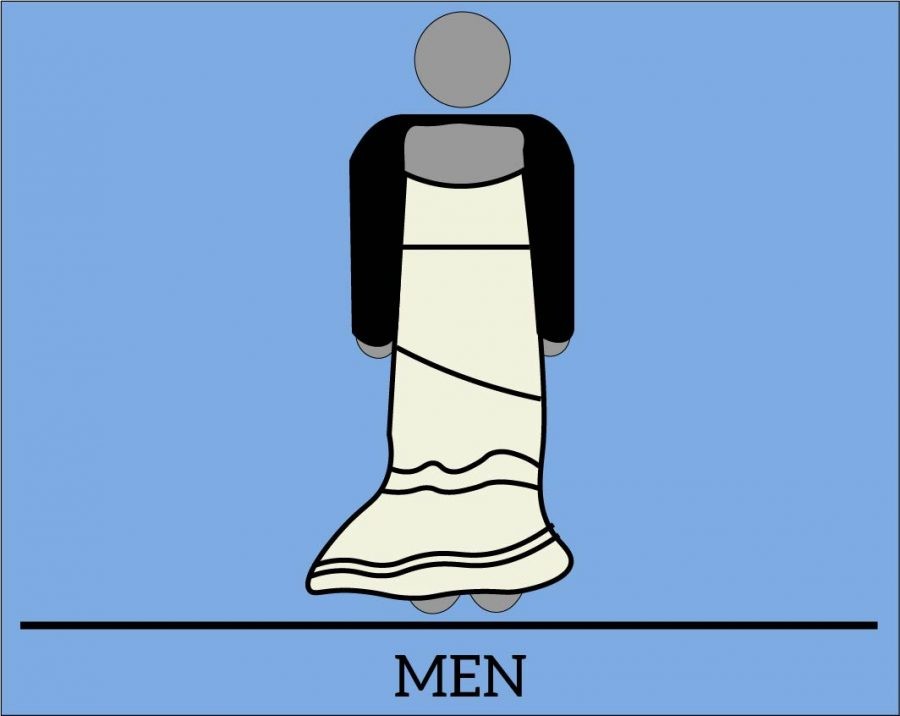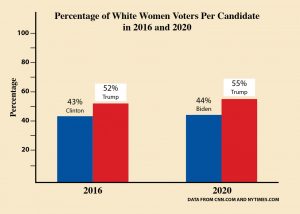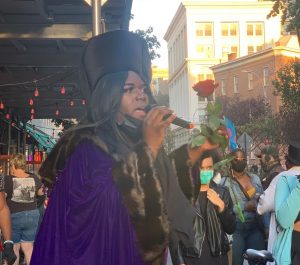What Is It About a Man in a Dress?
Conservative commentator Candace Owens sees a looming threat in Vogue’s first male cover star
December 3, 2020
According to conservative commentator and author Candace Owens, America as we know it is under attack. On Nov. 24, Owens bravely took to Twitter to warn the American people of a cunning menace threatening to wreak havoc upon Western society: Harry Styles in a dress.
The cover of Vogue magazine’s December issue features the singer in a grassy field sporting a Gucci jacket and gown with the title “Harry Styles Makes His Own Rules.” On Nov. 14, Vogue tweeted a photo of him in the dress as well as a quote from its cover story on Styles: “There’s so much joy to be had in playing with clothes. I’ve never thought too much about what it means — it just becomes this extended part of creating something.”
To this Owens responded, “There is no society that can survive without strong men. The East knows this. In the west, the steady feminization of our men at the same time that Marxism is being taught to our children is not a coincidence. It is an outright attack. Bring back manly men.”
Owens, ever the provocateur, resorts to fearmongering, playing into the standard conservative ideals of masculinity and femininity that at least a large fraction of her 2.8 million Twitter followers are bound to harbor. Owens seems to imply that the “feminization of men” is part of a broader scheme that goes hand-in-hand with an apparent infiltration of Marxist values in the minds of young Americans.
There is no society that can survive without strong men. The East knows this. In the west, the steady feminization of our men at the same time that Marxism is being taught to our children is not a coincidence.
It is an outright attack.Bring back manly men. https://t.co/sY4IJF7VkK
— Candace Owens (@RealCandaceO) November 14, 2020
Despite the fact that the quote from Styles explicitly states that he has “never thought much about” his fashion choices, Owens continues to assert that there must be some deeper meaning, that it has to be an “outright attack” on Western society as we know it, carried to fruition by the “liberal media.”
It’s hard to recall exactly where in his Vogue feature Styles mentions that “The Communist Manifesto” inspires his day-to-day fashion — he doesn’t, of course — but nonetheless, Owens seems to have found a connection between a man in Gucci on the cover of a fashion magazine and Marxism.
Owens’ tweet resulted in widespread criticism, triggering thousands of conservative followers and prompting them to rush to her defense. Conservatives often refer to the left as “weak,” but the fact that Styles in Gucci can send such intense shockwaves through the conservative community speaks to the fragility of the American political right.
Owens’ reference to “The East” contradicts itself, as her definition of a “manly man” is defined by Western prescribed gender norms.
To Owens and her followers, Styles’ Vogue debut represents a society in which men wearing traditionally feminine articles of clothing is normalized (oh, the horror!), making Owens’ extremely vague mention of “The East” all the more interesting.
While dresses have not been widely incorporated into typical men’s fashion in America, the genderfluid, non-heteronormative, androgynous hellscape Owens and her followers so deeply fear already exists.
For example, In Harajuku, a district of Tokyo, inhabitants are known for their bold and quirky streetwear. Outfits are often extravagant, mixed prints are common and genderbending is the norm.
In Indonesia, men can be seen in formal or casual sarongs, a skirt-like garment popular throughout Southeast Asia. The pervasiveness of Eurocentrism rears its ugly head with the realization that certain toxic standards continue to guide Western behavior. The notion that dresslike garments are a definitive indicator of whether or not someone qualifies as a “strong man” is as ignorant as it is disrespectful.
Owens’ reference to “The East” contradicts itself, as her definition of a “manly man” is defined by Western prescribed gender norms. While Owens’ comparison of the United States to “The East” is not only extremely broad, making for a confusing reference point, her definition of “strong” has yet to be elaborated on.
The word “strong” has different connotations depending on which gender it refers to. The phrase “strong woman” often alludes to certain personality traits that display a mental resilience, whereas a “strong man” is often defined by physical attributes displaying strength.
For Owens, Styles gracing the cover of Vogue in a dress is indicative of a future where a liberal “anything-goes mentality” trumps conservatism and all traces of traditional gender roles are erased.
Does she mean a man who is strong in his character? A man who holds fast to his values? Or is she referring to a man who feels as if he has to live by certain machismo standards and therefore is labeled as “strong”?
The public will never know, as when asked what constitutes a “strong” man, the best reply she could muster was “Since I’m trending I’d like to clarify what I meant when I said ‘bring back manly men’. I meant: Bring back manly men. Terms like ‘toxic masculinity’, were created by toxic females. Real women don’t do fake feminism. Sorry I’m not sorry.”
For Owens, Styles gracing the cover of Vogue in a dress is indicative of a future where a liberal “anything-goes mentality” trumps conservatism and all traces of traditional gender roles are erased. As concerned conservatives work to preserve and promote their cultural agenda, a publication like Vogue threatens to upend what they see as “right” with the release of a few photographs of a British man in a dress.














